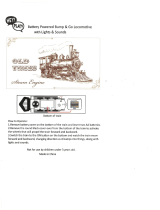
CAUTION: ELECTRICALLY OPERATED PRODUCT:
Not recommended for children under 10 years of age. M.T.H. recommends adult supervision with children ages 10 - 16.
As with all electric products, precautions should be observed during handling and use to reduce the risk of electric shock.
WARNING: When using electrical products, basic safety precautions should be observed, including the followi ng:
Read this manual thoroughly before using this device.
M.T.H. recommends that all users and persons supervising use examine the hobby transformer and other electronic equipment
periodically for conditions that may result in the risk of fire, electric shock, or injury to persons, such as damage to the primary
cord, plug blades, housing, output jacks or other parts. In the event such conditions exist, the train set should not be used until
properly repaired.
Do not operate your layout unattended. Obstructed accessories or stalled trains may overheat, resulting in damage to your layout.
This train set is intended for indoor or outdoor use. Do not use if water is present. Serious injury or fatality may result.
l
l
l
l Do not operate the hobby transformer with damaged cord, plug, switches, buttons or case.
Table of Contents
Set Up Checklist.................................................................................................... 3
Tender Coupler Installation................................................................................... 3
Lubrication............................................................................................. 5
Priming The Smoke Unit....................................................................................... 5
Placing The Engine On The Track........................................................ 6
Checking The Battery............................................................................ 6
DCS Polarity Switch.............................................................................. 7
Basic Operation.................................................................................................... 8
Activating Features(Using DC Power)................................................................... 8
Using DCS w/DCS Power..................................................................... 9
Activating Features Using AC Power................................................... 10
Proto-Sound 2.0 Operating Instructions .......................................................... 12
Activating Proto-Sound 2.0 Conventional Mode Features.................................... 12
Passenger Station Announcements(PSA).............................................................. 13
Speed Control........................................................................................................ 15
Locking Locomotive Into A Direction.................................................................. 16
Reset To Factory Default....................................................................................... 16
Automatic Sound Effects....................................................................................... 16
Maintenance......................................................................................................... 17
Lubricating and Greasing Instructions................................................................... 17
Traction Tire Replacement Instructions................................................................. 20
Light Bulb Replacement Instructions.................................................................... 21
Self Charging Battery Back-Up............................................................................. 22
ProtoSmoke® Unit Operation............................................................................... 23
Troubleshooting Proto-Sound® 2.0 Problems...................................................... 24
Transformer Compatibility and Wiring Chart....................................................... 27
Additional Features Accessible With The DCS System.................................................... 29
Service & Warranty Information........................................................................... 30
Limited One-Year Warranty................................................................................. 30
Participating Retailer List..................................................................................... 31





















